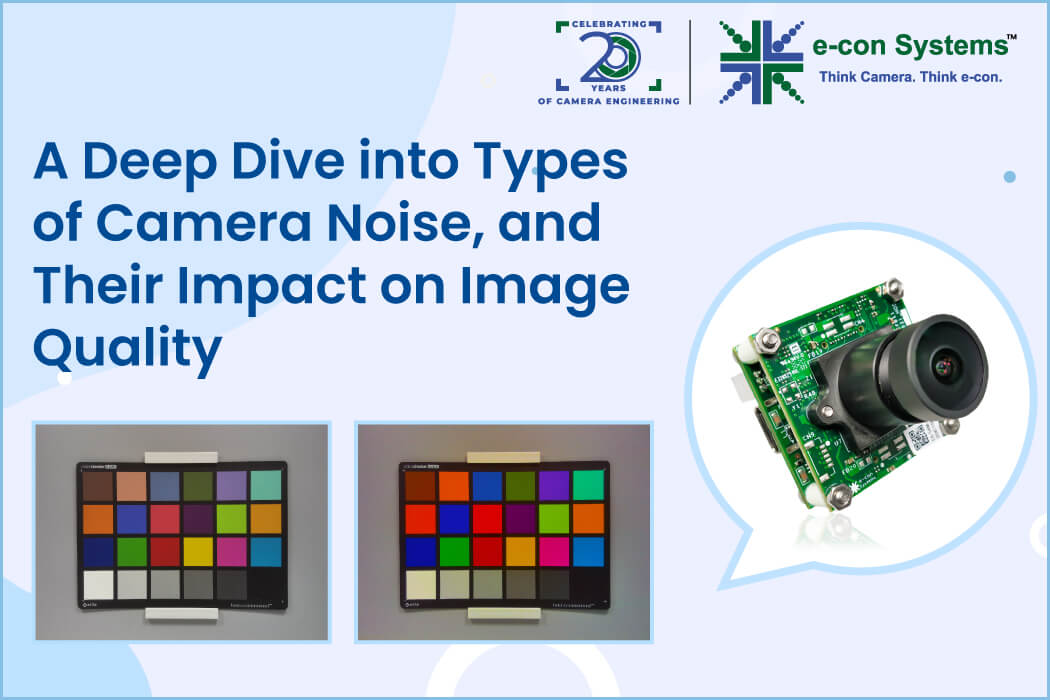Embedded vision systems have become integral components across various sectors, including healthcare, manufacturing, automotive, and more. Hence, the image quality captured by these embedded vision cameras is crucial, directly affecting the system’s ability to perform accurate analysis, decision-making, and action initiation. However, a persistent challenge in optimizing these systems is managing and mitigating camera noise, which can degrade image quality.
Understanding Camera Noise in Embedded Vision Systems
Camera noise refers to any unwanted signal variation in captured images that does not originate from the scene being imaged. This noise can manifest as random pixel variations (graininess) or color artifacts, detracting from the accuracy of the image data and lowering the system’s effectiveness.
The origins of camera noise can be attributed to factors such as the physical and electronic properties of the imaging sensor itself, as well as the operational environment and conditions.
Factors Influencing Noise Levels
- Sensor size: Larger sensors generally produce images with lower noise because they capture more light, reducing the need for signal amplification that introduces noise.
- Pixel density: High pixel density on a sensor can lead to increased noise. As the size of each pixel decreases to accommodate more pixels, the amount of light each pixel can capture diminishes, making the sensor more susceptible to noise.
- Lighting conditions: The level of ambient light plays a big role in the amount of noise present in an image. Low-light conditions call for higher sensor sensitivity (ISO), amplifying the desired signal and unwanted noise.
- Temperature: Embedded vision systems operating in high-temperature environments may exhibit increased thermal noise due to the elevated thermal energy within the sensor and its circuitry.
Types of Camera Noise in Embedded Vision Systems
Digital noise
Digital noise occurs during the analog-to-digital conversion process and the subsequent signal processing. It is characterized by random pixel variations that do not correspond to the actual scene. Quantization noise is a prevalent form, resulting from the finite resolution of digital systems in representing continuous signals.
Color noise
Color noise manifests as random, false color variations in the image, often visible as colored speckles in areas that should appear uniform. This type of noise is disruptive in embedded vision systems that rely on accurate color information for tasks like quality inspection or medical imaging.
Luminance noise
Luminance noise affects the brightness of pixels across the image, leading to graininess that can obscure fine details. It compromises the sharpness of the image, making it challenging for embedded vision systems to detect subtle features or patterns.
Fixed Pattern Noise (FPN)
FPN is a non-random noise that remains constant across multiple captures under the same conditions. It arises from imperfections in the sensor or variations in pixel response. In some applications, FPN can lead to consistent errors in image analysis.
Spatial Noise
Spatial noise varies across the image and includes random noise and patterned interference. Sensor defects, processing algorithms, or external environmental factors can cause it. The variability can severely affect system reliability, especially in those that need consistent image quality across the entire field of view.
Impact of Camera Noise on Image Quality
Reduction in detail and sharpness
Noise, especially luminance noise, can obscure the finer details of an image, reducing its overall sharpness. The degradation is problematic in applications, such as the ones used for inspecting manufactured goods for defects or analyzing medical images where detail is critical for accurate diagnoses.
The graininess introduced by noise can mask subtle textures, edges, and patterns, making it tough to detect or classify features accurately.
Compromised color accuracy
Color noise introduces random variations that can distort the true colors of the image. This distortion is detrimental to applications like color-based sorting systems in recycling plants or quality control in food production. Accurate color representation ensures that embedded vision systems can correctly identify and classify objects based on color.
Reduced dynamic range
Noise impacts an image’s dynamic range – the range between the darkest and brightest parts captured by the camera. High levels of noise, particularly in dark regions of an image, can compress the dynamic range, making it difficult to distinguish between subtle gradations of light and shadow.
The compression can hinder the system’s ability to interpret scene content accurately, affecting its decision-making capabilities.
Increased false positives /negatives
Noise can lead to inaccurate interpretations of image content, resulting in increased false positives or negatives in object detection and classification tasks. For instance, noise might be misinterpreted as a defect in quality inspection applications, leading to the unnecessary rejection of good products.
Conversely, it may mask actual defects, allowing faulty items to pass through and compromising the quality assurance process.
Image processing/analysis challenges
Noise complicates image processing and analysis; hence, intensive algorithms are needed to distinguish between noise and true image content. Noise can lead to increased processing times and higher power consumption, which are major considerations in embedded systems where resources and power may be limited.
Moreover, noise reduction techniques themselves, if not carefully applied, can result in the loss of important details, thereby complicating the image analysis process.
Popular Noise Reduction Techniques
Understanding and controlling camera noise is essential as many applications demand high image data reliability, which requires noise reduction techniques. Mitigating the impact of noise on image quality involves strategies implemented within the camera (in-camera noise reduction) and after image capture (post-processing).
In-camera noise reduction
These in-camera techniques balance noise reduction with the preservation of image detail, which means they require advanced algorithms.
- Temporal noise reduction: Comparing sequential frames to identify and reduce noise is beneficial in video or rapid image capture scenarios.
- Spatial noise reduction: Filtering techniques applied to individual frames to smooth out noise while preserving detail, useful in static image capture.
Post-processing for noise reduction
Post-capture processing offers additional opportunities to reduce noise and improve image quality. It provides a second line of defense against noise when raw images from embedded vision systems require further refinement for analysis or presentation.
Post-processing techniques often employ advanced filtering algorithms that filter noise based on image content and noise characteristics. They also leverage AI and Machine Learning models that are trained to identify and remove noise while enhancing image details.
e-con Systems Provides World-Class Low-Noise Cameras
e-con Systems has over 20+ years of experience in designing, developing, and manufacturing OEM cameras. Over the decades, we have built a portfolio of low-noise cameras for various embedded vision use cases, including medical, manufacturing, retail, smart farming, and more.
Visit our Camera Selector page to explore our complete camera portfolio.
If you need help customizing and integrating low-noise cameras into your products, please write to camerasolutions@e-consystems.com.

Prabu is the Chief Technology Officer and Head of Camera Products at e-con Systems, and comes with a rich experience of more than 15 years in the embedded vision space. He brings to the table a deep knowledge in USB cameras, embedded vision cameras, vision algorithms and FPGAs. He has built 50+ camera solutions spanning various domains such as medical, industrial, agriculture, retail, biometrics, and more. He also comes with expertise in device driver development and BSP development. Currently, Prabu’s focus is to build smart camera solutions that power new age AI based applications.




